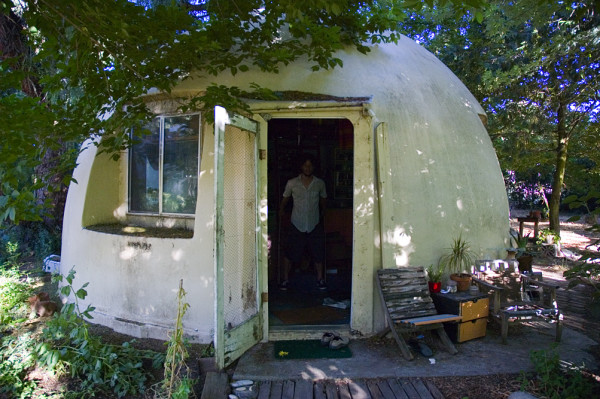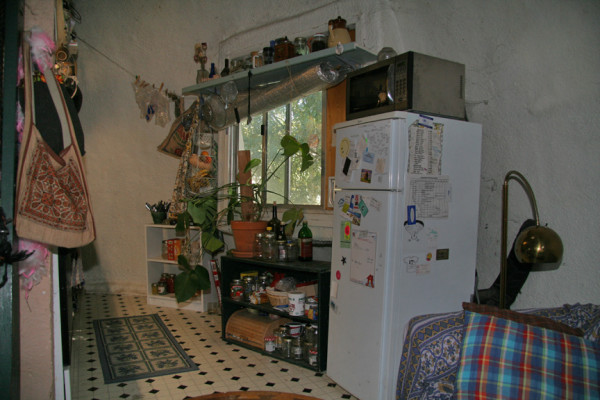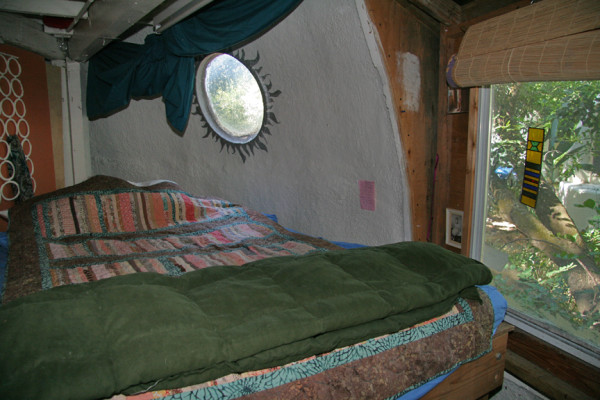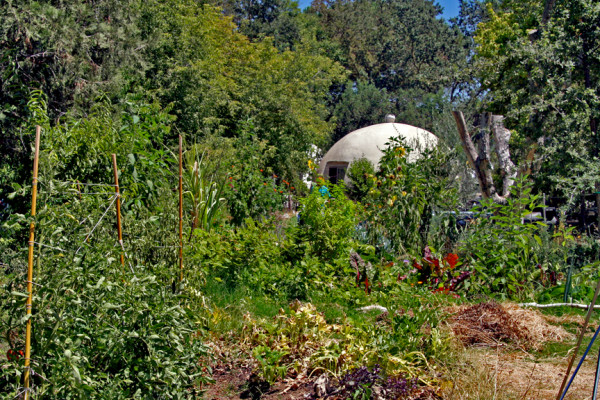Baggins End, on the campus of the University of California, Davis is a small community of undergraduate and graduate students who live together in a bundle of round, white domes among several acres of community gardens, chicken coops, trees and flowers. Sounds idyllic, right? The students think so and are prepared to fight for their little slice of heaven. Recently, the university has determined that the domes are no longer safe for residential use and plan to shut down the Domes and Baggins End this summer.
The university’s student housing department said the Domes are not up to code, are not Americans With Disabilities Act-compliant, and not worth spending money on to salvage. Supporters of the Domes claim the university administration has neglected these issues for decades and is trying to make a land grab, motivated by budget cuts and pressure to squeeze every last dollar out of campus real estate.
Sacramento News & Review Article on Baggins End
Sacramento Public Radio Story on Baggins End
The Domes have been on the campus since 1972 and are constructed of three to four inches of polyurethane foam surrounded by a fiberglass shell. A few of the Domes are beginning to delaminate. Baggins End (named after the home of Bilbo and Frodo Baggins from The Hobbit and the Lord of the Rings trilogy) is comprised of 14 domes housing 28 students where they emphasize cooperation and sustainability. The students grow a lot of their own food and raise chickens and a rooster named Chamomile. The Domes are around 450 square feet and contain a kitchen, living room, two bedrooms or a sleeping loft, heating and skylights. The students are allowed to perform their own construction projects and have access to the community’s free materials yard, fire pit, garden and tool shed, compost pile, greenhouse and the weekly potluck dinners. Each resident pays $2,712 for a year long lease.
A company that inspected the Domes estimated that it would take more than $600,000 – or $43,000 per dome – to resolve problems with the structures’ delamination. Chris Adamson, a state-certified access specialist in UC Davis’ Design and Construction Management unit, estimated that it would cost an additional $300,000 to make the ADA improvements.
As a self-supporting unit, the Davis student housing department does not receive state or campus funding, and each housing area must operate as a self-supporting unit. A plan is in place to rebuild the Domes, but that could take up to five years. In the meantime, student residents are looking for alternative solutions to keep their inexpensive housing in a creative and supportive community.
Photos Courtesy of the Domes at Baggins End
By Christina Nellemann for the [Tiny House Blog]








I would seriously look into thick earthen plasters over the dome skins and possibly even roofs to help protect them even more from the elements.
from the pictures those exterior windows are horrible water traps!! I see so many things that can be done to extend the lives of the structures for many many years to come! and ADA compliance is not hard to achieve in a small place like these.
I LUV THESE LITTLE DOME HUTS – ESPECIALLY THE WAY THEY ARE DECORATED – THEY ALSO HAVE GARDENS/CHICKENS – MORE LIKE BACK IN THE 60’S – PEOPLE SHOULD BE MORE LIKE THIS SELF SUFFICIENT IT’S ANOTHER STORY OF THE GOVERNMENT GETTING THEIR NOSE INTO THINGS THAT AREN’T THAT IMPORTANT –
beautiful! it looks so cozy! ^^^ My dream house ^^^
Can it really cost that much to fix these domes? Doesn’t sound like a good use of money. You could probably build brand new homes more easily, especially using natural building techniques. ADA compliance would mean wider doorways and ramps, much easier to put in new buildings. Perhaps they could bring in temporary housing in the short term then just replace the domes with better built houses rather than shut the whole thing down. Given the number of possible solutions that aren’t being considered you might just come to the conclusion that the land grab theory is pretty solid. Maybe they could design the new housing in such a way that it still retains the village feel but houses more people?
I agree Alice. This might be a great opportunity for the students and UC Davis to look into all the tiny house options out there. Maybe they can make the project a new program and use tuition money from the program for rebuilding. However, the university politics and red tape may stop any forward movement.
Looks like they have several departments that could benefit from a project like that. You just have to shake your head sometimes at the lack of common sense and obstructive regulations that serve no useful function.
They’re in California, right? They should look into having a couple of cob consultants come down and help them build new little domes houses. Aren’t the folks from Cob Cottage Company up in Oregon? Anywho, if they dismantle the old domes, I’m sure a lot of the materials could be re-purposed (Styrofoam could go into the foundation insulation, etc.) and re-build with cob, it would help save a ridiculous amount of money and the students could lobby to protect the social experiment/community lifestyle they have set up. If the university doesn’t reach for a compromise with these students, their underlying motives will be all to apparent.
The numbers they assume for solving the delimitation and ADA issues seem outrageous, it seems pretty clear that the U is motivated to use this property for something more ‘profitable’. It is very unfortunate that governments and institutions do not see the value in these types of community developments. For a fraction of the cost there are several companies that specialize in small scale prefabricate and modular housing, many using sustainable materials and emphasize modern efficiency in design.
It is good to see these types of communities alive and over time hopefully laws and regulations will evolve to be more open minded. Interestingly ,here in Colorado we are seeing a large increase in the popularity of urban backyard chickens.
Yes, I bet that company that inspected the domes saw $$ signs in their eyes when giving this ridiculous estimate and would no double double it once they got involved.
There are so many simple ways these domes can be fixed up inexpensively…this “U” wants the land for another reason; I agree wholeheartedly with the other commentators.
I hope they can keep them. They are actually of historical interest, I would think.
First, the university goes to an outside profit making company for a bid. So you can blow off 40% of the estimates to cover profit and overhead. Talk about gaming the data!
This is a university, for crying out loud. The students who originally erected these units thought outside the box and came up with a solution that served well for 40 years.
If the university is committed to serving the students, they need to challenge them to refurbish, repair, and update the cottages. Barring that, the challenge should be to replace the units with modern designed, sustainably built housing using the most effective, most innovative solutions the students can devise.
The whole country could benefit from the learning experience of a new generation of students given an opportunity for real world applications of concept.
In stead of investing in the students and the future, the university is committed to funding another season of administrative malarkey.
Y’all are right – it’s a land grab.
Absolutely a land grab.
It’s also short term thinking on the part of the college. I hope the agricultural, architectural and even political science departments jump in with thoughtful solutions that enhance both the university’s teaching mission and the student’s learning experiences. With “green” on the mind of many college age thinkers and innovators, this could be PR like the college never dreamed. Get some celebs involved, or famous, rich alums and fund a resolution!
43,000 per dome??? C’mon, somebody is trying to make a killing here! You could use the Cal-earth superadobe method and go right over the existing structure and never have to worry about it again! Very inexpensive also!
It seems like it would be cheaper to recreate the domes than to repair them. One could build them to meet codes. I think they are neat.
Rent on each dome is about $450 a month…based on the per student rate…
not much in the California real estate market…no wonder they are being railroaded.
Why not look at buiding a new set of cottages one by one.Each student could temporarily move into another dome and replace theirs with something like the peace dome or tower house I found at dreamgreenhomes.com.:} These buildings are made of earthbag construction, are low cost and can be built by the students. Also the buildings would stand up to earthquakes,fire,rain/mold,and be very energy efficient.
There does seem to be something wrong with the estimates for the houses, as well as the time to complete the update. The University could contact one of the Yurt companies to build yurts to replace these domes fairly easily, and not take 5 years to complete. At the same time, there are several sources of plans that could be used to replace the domes with other tiny houses. It will be interesting to hear how this story develops.
My wife lived in the domes when she went to Davis. She has very fond memories of those years, and we keep a picture of her dome in our house to remind us of simpler times. Thanks for sharing, and I do hope they find a way to keep the alternative student housing alive.
The problem is, there are to be no alternatives. I can tell you right now how it will end – BULLDOZERS. Sorry but anything that suggests an alternative lifestyle, or alternative answers, will simply not be tolerated. When SOMEONE has gone to all the trouble of cooking up numbers,citeing laws, and rationalizing excluding input from logical sources…… you are in for a fight.
s
$43K per dome? Only a government employee would be so dumb as to think that was a reasonable price. They don’t care because it’s not THEIR money, RIGHT?
Get somebody in there who can really help them, starting with telling the truth.
Prevailing wage is the culprit. As contractors, we have done work on college campuses, and it is always required to be at prevailing wage. A project may end up costing 40% more than it would have if it were private sector because of the record keeping and wage requirements of prevailing wage. It costs the government (taxpayers) tons of money, and is actually a bigger pain for the contractors as well.
Hey, all;
I’m a current Domes resident, working hard on the fight to keep the space alive. The initial estimates from the Uni were indeed horribly overpriced; ADA estimates included $9000 for three raised planter boxes, for example. (I’m thinking of starting a gardening business, with this as a key part of my plan.)
We’re currently assembling a plan to lease the space over the next 3-5 years with a local non-profit cooperative housing group, which would keep the space occupied while we envision what the next round of structures will be. We’re hoping to start building an academic program around sustainability into the space, so that’s going to be a big part of the planning process, and will likely impact the kinds of structures we end up with. For example, there’s talk of working with Engineers Without borders or similar organizations to build ‘local copies’ of some of the kinds of project work they do in developing countries.
We’re in a positive moment right now, but there’s still a lot of work to be done. If talks with administration go well over the next couple weeks, we’ll be starting a funds drive to raise around $50,000 to keep the space up for five more years. We’re also having a massive community work party on April 3rd, if anyone wants to drop by…
If you have any questions or want to get involved, you can join our facebook group (Save the Domes) or email us at savethedomes(at)gmail(dot)com.
Thanks so much for your kind words!
Best of luck to you, sounds like you have things well in hand. It’s encouraging that people are working on solutions and not just bemoaning your fate. Good work!
To bring everyone up to speed: the Domes are saved!
Everything that Tom D mentioned above has happened, culminating in a 250-person volunteer work party in November and the leasing of the Domes to Solar Community Housing Association just last week.
http://www.facebook.com/groups/135727449826471/258944420838106/